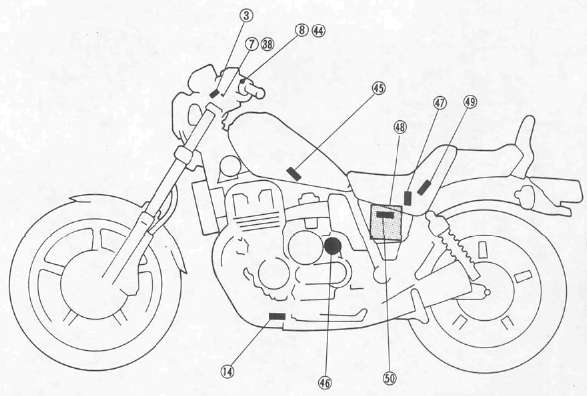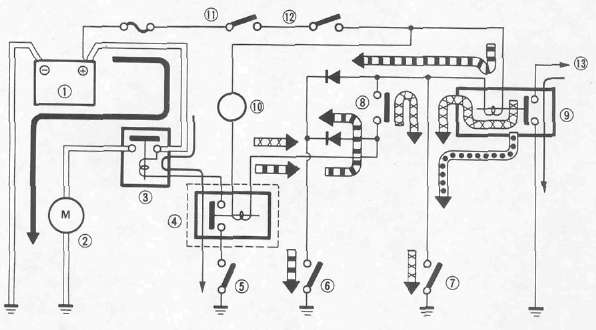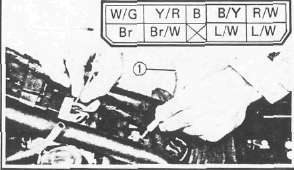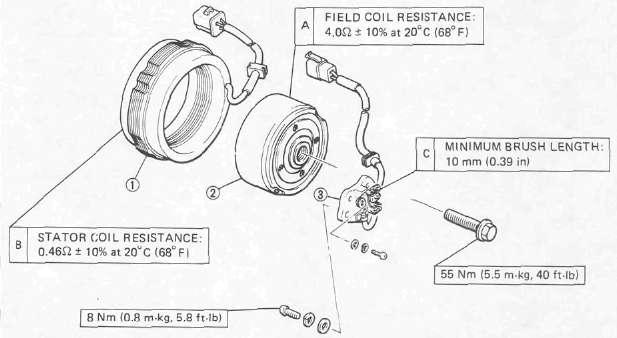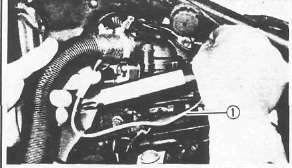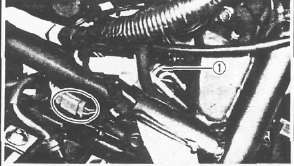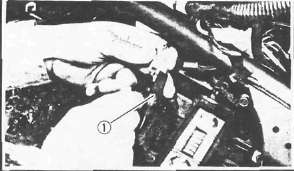Chapter 7, ELECTRICAL
Chapter 7, ELECTRICALXJ700XS CIRCUIT DIAGRAM
1 A.C. Generator
2 Rectifier/Regulator
3 Main switch
4 Fuse "FAN" (10A)
5 Thermo switch
6 Fan motor
7 Fuse "IGNITION" (10A)
8 "ENGINE STOP" switch
9 Pickup coil
10 T.C.I, unit
11 Ignition coil (#2, #3)
12 Ignition coil (#1, #4)
13 Sidestand relay
14 Sidestand switch
15 Tachometer
16 "FUEL" warning light
17 Fuel sender
18 Temperature meter
19 Thermo unit
20 Horn
21 "HORN" switch
22 Flasher relay (Relay assembly)
23 Flasher switch
24 Reed switch
25 Flasher light (Front, Right)
26 Flasher light (Rear, Right)
27 "TURN" indicator light (Right)
28 "TURN" indicator light (Left)
29 Flasher light (Rear, Left)
30 Flasher light (Front, Left)
31 "OIL LEVEL" indicator light
32 Oil level switch
33 "NEUTRAL" indicator light
34 Neutral switch
35 Fuse "SIGNAL" (15A)
36 Brake switch
37 Tail/Brake light
38 Clutch switch
39 Fuse "HEAD" (15A)
40 Meter light
41 Head light
42 "HIGH BEAM" indicator light
43 "LIGHTS" (Dimmer) switch
44 "START" switch
45 Starting circuit cut-off relay (Relay assembly)
46 Starter motor
47 Starter relay
48 Battery
49 Fuse "MAIN" (30A)
50 Diode assembly
51 Diode (in wire harness)
COLOR CODE
|
0 |
Orange |
Lg |
Light green |
B/Y |
Black/Yellow |
|
R |
Red |
Y/G |
Yellow/Green |
L/W |
Blue/White |
|
L |
Blue |
Y/R |
Yellow/Red |
L/G |
Blue/Green |
|
Br |
Brown |
Y/B |
Yellow/Black |
L/R |
Blue/Red |
|
B |
Black |
Y/L |
Yellow/Blue |
L/B |
Blue/Black |
|
Y |
Yellow |
Br/W |
Brown/White |
G/L |
Green/Blue |
|
W |
White |
R/B |
Red/Black |
G/R |
Green/Red |
|
G |
Green |
R/L |
Red/Blue |
G/Y |
Green/Yellow |
|
P |
Pink |
R/W |
Red/White |
G/W |
Green/White |
|
Dg |
Dark green |
R/Y |
Red/Yellow |
W/R |
White/Red |
|
Ch |
Chocolate |
B/R |
Black/Red |
W/B |
White/Black |
|
Gy |
Gray |
B/W |
Black/White |
W/G |
White/Green |
|
Sb |
Sky blue |
|
|
|
|
Electrical Components
Electrical ComponentsELECTRICAL COMPONENTS 1

1 Ignition coil
2 Thermo switch
3 Thermo unit
4 Main switch
5 Sidestand switch
6 Battery
7 T.C.I, unit
8 Rectifier/Regulator
9 Oil level switch
10 Rear brake switch
11 Neutral switch
IGNITION COIL:
PRIMARY WINDING RESISTANCE: 2.7Ω ± 10%
SECONDARY WINDING RESISTANCE: 12kΩ±20%
BATTERY:
CAPACITY: 12V 14AH
SPECIFIC GRAVITY: 1.280

ELECTRICAL COMPONENTS 2
1 Horn
2 Sidestand relay
3 Diode assembly
4 Relay assembly {Flasher relay, Starting circuitcut-off relay)
5 Starter switch
6 Stator coil
7 Field coil (Rotor)
8 Brush
9 Pickup coil assembly
10 Fuel sender
PICKUP COIL RESISTANCE: 120Ω ± 10%(B-Gy, G-O)
STATOR COIL RESISTANCE: 0.46Ω ± 10% (W-W)
FIELD COIL RESISTANCE: 4.0Ω ± 10% (Direct)
MINIMUM BRUSH LENGTH: 10 mm (0.39 in)
Electric Starting System
Electric Starting SystemELECTRIC STARTING SYSTEM
3 Main switch
7 Fuse "IGNITION" (10A)
8 "ENGINE STOP" switch
14 Sidestand switch
39 Fuse "HEAD" (15A)
44 "START" switch
45 Starting circuit cut-off relay (Relay assembly)
46 Starter motor
47 Starter relay
48 Battery
49 Fuse "MAIN" (30A)
50 Diode assembly
STARTING CIRCUIT OPERATION
The starting circuit on this model consists of the starter motor, starter relay, starting circuit cutoff relay, and sidestand relay. If the engine stop switch and the main switch are both on, the starter motor can operate only if:
• The transmission is in neutral (the neutral switch is on.)
• The sidestand is up (the sidestand switch is on) and the clutch lever is pulled in (clutch switch is on.)
![]() When the transmission is in neutral.
When the transmission is in neutral.
 When the sidestand is up and the clutch lever is pulled in.
When the sidestand is up and the clutch lever is pulled in.
 When the engine is running.
When the engine is running.
1 Battery
2 Starter motor
3 Starter relay
4 Starting circuit cut-off relay
5 Starter switch
6 Neutral switch
7 Sidestand switch
8 Clutch switch
9 Sidestand relay
10 Tachometer
11 Main switch
12 Engine stop switch
13 To ignitor unit
|
Turn main switch to "ON" and engine stop switch to "RUN" |
|
|
Transmission is |
|
|
▼ |
▼ |
|
In neutral |
In gear |
|
▼ |
▼ |
|
Push starter switch Engine will start |
Raise Sidestand and Pull in clutch lever |
|
▼ |
▼ |
|
Ensure Sidestand is up |
Push starter switch: Engine will start |
|
▼ |
▼ |
|
Motorcycle can be ridden |
|
TROUBLESHOOTING CHART
|
THE STARTER MOTOR DOES NOT OPERATE. |
|
|
|
▼ |
|
|
|
|
||
|
Connect "L/W" lead from the starter relay 1 to the battery negative (-) terminal 2 ; use a jumper lead. |
► |
The engine does not rev smoothly. |
|
▼ |
||
|
Recharge or replace the battery. |
||
|
|
||
|
► |
The engine does not operate. | |
|
▼ |
||
|
▼ |
|
|
|
Check the battery voltage (12V) on the "L/W" lead from the starter relay. |
||
|
The engine operates. |
||
|
▼ |
||
|
▼ |
||
|
Main and engine stop switches are turned to "ON". |
||
|
If the starter relay does not click, check the starter relay and starter motor. |
||
| ▼ | ||
|
|
||
|
|
||
|
Connect "B/Y" lead to "ground" on the frame; use a jumper lead 1. |
||
|
► |
|
|
|
If the relay unit does not click, check the battery voltage (12V) on the "R/W" lead. |
||
|
|
▼ |
|
|
Check for an open or poor connection between the main switch and relay unit. |
||
|
▼ |
||
|
If the relay unit clicks, check the starter, sidestand, clutch and neutral switches. Replace switch(es) if necessary. |
|
|
STARTING CIRCUIT CUTOFF RELAY (Relay Assembly)
1. Remove:
• Seat
• Fuel tank
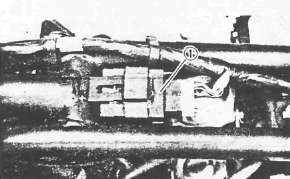
• Relay assembly 1
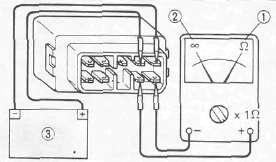
2. Check the relay contacts Use 12V battery 3 and Pocket Tester (90890-03112). Replace relayif out of specification.
Battery Connected: 0Ω 1 Battery Disconnected: ∞ 2
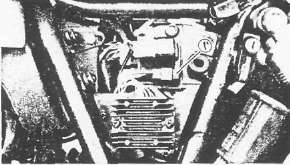
DIODE
1. Remove:
• Left side cover
• Diode 1
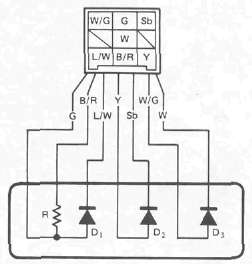
2. Check:
• Diode continuity/discontinuity
Defective element(s) -> Replace the unit.
|
Checking element |
Pocket tester connecting point |
Good |
|
|
(+) (red) |
(-) (black) |
||
|
D1 |
G |
L/W |
O |
|
L/W |
G |
X |
|
|
D2 |
Y |
Sb |
O |
|
Sb |
Y |
X |
|
|
D3 |
W/G |
W |
O |
|
W |
W/G |
X |
|
|
R |
G |
B/R |
8.2Ω |
O: Continuity (0Ω) (Scale Ω x 1k)
x : Discontinuity (∞) (Scale Ω x 1)
NOTE:
The results "o" or "x" should be reversed according to the pocket tester polarity.
NEUTRAL SWITCH

1. Remove:
• Left side cover
• Panel
2. Check the neutral switch contact. Replace if out of specification.
|
Shift pedal 3 |
In neutral |
In gear |
|
Tester |
0Ω |
∞Ω |
1 Blue lead
2 Ground
SIDESTAND SWITCH
1. Refer to neutral switch removal steps.
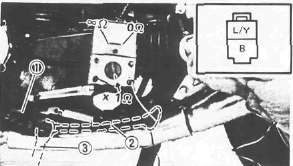
2. Check the sidestand switch 1 contact. Replace switch if out of specification.
|
Sidestand |
Up 2 |
Down 3 |
|
Tester |
0Ω |
∞Ω |
CLUTCH SWITCH
1. Remove headlight unit
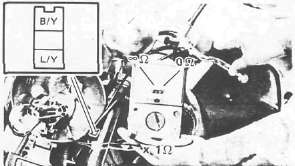
2. Check clutch switch contact. replace if out of specification.
|
Clutch lever |
Pull in |
Not pull in |
|
Tester |
0Ω |
∞Ω |
STARTER SWITCH
1. Remove the headlight unit.

2. Check starter switch contact. Replace if out of specification.
|
Starter switch |
ON |
OFF |
|
Tester |
0Ω |
∞Ω |
STARTER RELAY Inspection
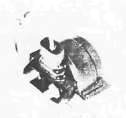
Preparation steps:
• Disconnect starter motor red lead.
• Connect Pocket Tester leads to relay terminals.
•Turn main switch to "ON".
• Turn engine stop switch to "RUN".
• Move shift pedal to "NEUTRAL"

|
Push starter switch to "ON" |
||
|
▼ |
▼ |
|
|
Relay clicks and tester reads 0Ω |
Relay does not click and tester does not read 0 Ω |
|
|
▼ |
▼ |
|
|
OK |
Measure resistance: |
|
|
|
||
|
▼ |
▼ | |
|
Resistance less than 1 Ω |
Resistance more than 1 Ω | |
|
▼ |
▼ | |
|
Check connections |
Replace relay | |
Starter Motor
Starter MotorSTARTER MOTOR
1 O-ring
2 Brush
3 Armature
4 Washer
5 Circlip
Removal
Refer Chapter 3. "ENGINE DISASSEMBLY".
Inspection
1. Inspect commutator outer surface. Clean with 600 grit sandpaper if dirty. Check mica insulation between commutator segments and scrape mica to proper limits. Use a hacksaw blade that is ground to fit.

Mica Undercut 1 : 0.4 - 0.8 mm (0.02 - 0.03 in)
NOTE:
The mica insulation of commutator must be under-cut to ensure proper operation of commutator.

2. Measure the armature coil continuity 1. Replace or rewind starter motorif necessary.
Armature Coil: 0.014Ω ± 6% at 20°C (68° F)
Measure the armature coil insulation 2. Replace the starter motor if shorted.

3. Inspect:
• Front cover bearing 1
• Center and rear covers bushings 2
Replace if damaged.
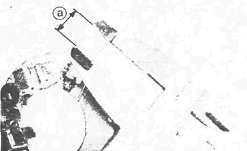
4. Measure the length of each brush length a and replace if less than minimum length.
Minimum Brush Length: 8.5 mm (0.34 in)
5. Check the brush spring pressure and compare with new spring. Replace spring if weak.
Charging System
Charging SystemCHARGING SYSTEM
1 A.C. Generator
2 Rectifier/Regulator
3 Main switch
48 Battery
49 Fuse "MAIN" (30A)

CHARGING VOLTAGE INSPECTION
1. Remove seat
2. Connect Pocket Tester leads (to each battery terminal)
3. Start the engine.
4. Measure the charging voltage. Rev engine to approximately 3,000 r/min or more.
Charging Voltage: 14.2 ~ 14.8 V
TROUBLESHOOTING
| Check voltage. | ◄ ◄ ◄ ◄ | ◄ | |
| Not within specification ▼ | ▲ | ||
|
Inspect all connections |
Defective ► | Correct.► | ▲ |
| OK ▼ | |||
| Measure the battery for voltage and specific gravity. Battery voltage: More than 12V Specific gravity: 1.280 |
Less than specification: ► | Recharge the battery. | |
|
OK ▼ |
|||
|
Remove the generator assembly and check the brush length, rectifier, and coil resistance. Minimum brush length: 10 mm (0.39 in) |
Less than specification: ► | Replace the defective part(s). | |
|
OK ▼ |
|||
| Replace rectifier/regulator. | |||
BATTERY
NOTE:
Replace the battery if:
•Battery voltage will not rise to a specific value or bubbles fail to rise even after many hours of charging.
•Sulfation of one or more cells occurs, as indicated by the plates turning white, or an accumulation of material exists in the bottom of the cell.
•Specific gravity readings after a long, slow charge indicate one cell to be lower than the rest.
•Warpage or buckling of plates or insulators is evident.
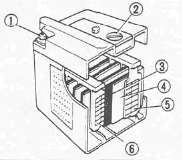
1 Terminal
2 Cap
3 Insulator
4 Separation plate
5 Negative electrode
6 Positive electrode
1. Inspect the battery terminals and battery couplers. Clean off any corrosion. Tighten as required.
2. Measure the specific gravity of battery fluid. Remove and recharge battery if less than 1.280
CAUTION:
To insure maximum battery performance be sure to:
• Charge a new battery before use.
• Maintain proper electrolyte level.
• Charge at proper current; 1.4 amps/10 hrs. or until the specific gravity reaches 1.280 at 20°C(68°F).
Failure to observe these points will result in a shortened battery life.

WARNING:
Battery electrolyte is dangerous; it contains sulfuric acid and therefore is poisonous and highly caustic.
Always follow these preventive measures:
•Avoid bodily contact with electrolyte as it can cause severe burns or permanent eye injury.
•Wear protective eye gear when handling or working near batteries. Antidote (EXTERNAL):
•SKIN - Flush with water.
•EYES — Flush with water for 15 minutes and get immediate medical attention. • Drink large quantities of water or milk and follow with milk of magnesia, beaten egg, or vegetable oil. Get immediate medical attention.
Batteries also generate explosive hydrogen gas, therefore you should always follow these preventive measures:
• Charge batteries in a well-ventilated area.
• Keep batteries away from fire, sparks, or open flames (e.g., welding equipment, lighted cigarettes, etc.)
• DO NOT SMOKE when charging or handling batteries. KEEP BATTERIES AND ELECTROLYTE OUT OF REACH OF CHILDREN.
Battery Service Life
The service life of a battery is usually two to three years. Battery life may be shortened by poor maintenance.
Preparation steps:
• Keep battery topped off with distilled water.
• Keep battery charged.
• Do not overcharge battery.
• Do not allow battery to freeze.
• Do not fill with tap water or sulfuric acid containing impurities.
• Do not charge new battery using improper voltage or current.
Battery Storage
The battery should be stored if the motorcycles is not to be used for a long period.
1. Remove the battery.
Battery storage and maintenance tips:
• Recharge the battery periodically.
• Store the battery in a cool, dry place.
• Recharge the battery before reinstalling.
|
Battery |
YB14L |
|
Electrolyte |
Specific gravity: 1.280 |
|
Initial charging rate |
1.4 amp for 10 hours (new battery) |
|
Recharging rate |
10 hours (or until specific gravity reaches 1.280) |
|
Refill fluid |
Distilled water (to maximum level line) |
|
Refill period |
Check once per month (or more often as required) |
1 Field coil
2 Stator
3 Brush
GENERATOR ASSEMBLY

1. Remove:
• Left side cover
• Panel
2. Measure the stator coil resistance
Stator Coil Resistance: 0.46Ω ± 10% at 20°C (68°F) (W-W)

3. Remove the A.C.G. cover
4. Measure the field coil resistance
Field Coil Resistance: 4.0Ω ±10% at 20°C (68°F)
5. Inspect the brush contact areas. Clean with 600 grit sandpaper if dirty.
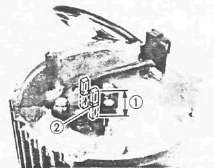
6. Measure each brush length 1. Replace if shorter than minimum.
Minimum Brush Length: 10 mm (0.39 in)
2 Wear indicator
7. Inspect the brush springs Compare with new spring.
RECTIFIER/REGULATOR

1. Remove:
• Left side cover
• Panel
2. Check Rectifier/Regulator 1 diodes (Refer to the following table.)
Defective element — Replace rectifier.

1 White
2 White
3 White
4 Red
5 Ground
6 Brown
A Regulator
B Rectifier
|
Checking |
Pocket tester |
Good |
|
|
(+) |
(-) |
||
|
D1 |
4 |
1 |
O |
|
1 |
4 |
X |
|
|
D2 |
4 |
2 |
O |
|
2 |
4 |
X |
|
|
D3 |
4 |
3 |
O |
|
3 |
4 |
X |
|
|
D4 |
1 |
5 |
O |
|
5 |
1 |
X |
|
|
D5 |
2 |
5 |
O |
|
5 |
2 |
x |
|
|
D6 |
3 |
5 |
O |
|
5 |
3 |
x |
|
O: Continuity X: Discontinuity (∞ )
CAUTION:
Do not overcharge rectifier or damage may result.
Avoid:
• A short circuit
• Inverting + and - battery leads
• Direct connection of rectifier to battery
NOTE:
The results "O" or "x" should be reversed according to the pocket tester polarity.
Ignition System
Ignition SystemIGNITION SYSTEM
3 Main switch
7 Fuse "IGNITION" (10A)
8 "ENGINE STOP" switch
9 Pickup coil
10 T.C.I, unit
11 Ignition coil (#2, #3)
12 Ignition coil (#1, #4)
13 Sidestand relay
48 Battery
49 Fuse "MAIN" (30A)
DESCRIPTION
This model is equipped with a battery operated, fully transistorized, breakerless ignition system. By using magnetic pickup coils, the need for contact breaker points is eliminated. This adds to the dependability of the system by eliminating frequent cleaning and adjustment of points and ignition timing. The TCI (Transistor Control Ignition) unit incorporates an automatic advance circuit controlled by signals generated by the pickup coil. This adds to the dependability of the system by eliminating the mechanical advancer. This TCI system consists of two units; a pickup unit and an ignitor unit.
OPERATION
The TCI functions on the same principle as a conventional DC ignition system with the exception of using magnetic pickup coils and a transistor control box (TCI) in place of contact breaker points.
Pickup Unit
The pickup unit consists of two pickup coils and a flywheel mounted onto the crankshaft. When the projection on the flywheel passes a pickup coil, a signal is generated and transmitted to the ignitor unit. The width of the projection on the flywheel determines the ignition advance.

1 Pickup coils
Ignitor Unit
This unit controls wave form, duty control, switching, electronic ignition advance, etc. The duty control circuit reduces electrical consumption by controlling the duration of the primary ignition current.

The ignitor unit 1 also has a protective circuit for the ignition coil. If the ignition switch is on and the crankshaft is not turning, the protective circuit interrupts the current flow to the primary coil after a few seconds. When the crankshaft is turning, however, the ignitor unit sends current to the primary coil.
1. Remove:
• Seat
• Left side cover
• Panel
• Ignitor unit 1
TROUBLESHOOTING
1. Start engine and warm-up a while, then turn it off.
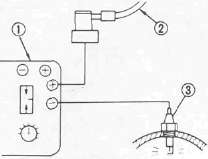
2. Connect Electro Tester (90890-03021) 1
2 Spark plug wire
3 Spark plug
3. Start engine and increase spark gap until misfire occurs (Test at various rpm between idle and red line.)
CAUTION:
Do not run the engine in neutral above 6,000 rpm for more than 1 or 2 seconds.
Minimum Spark Gap: 6 mm (0.24 in)
4. If ignition system becomes inoperative or engine misfires see the troubleshooting chart below:
Troubleshooting Chart
|
Check entire ignition connections. |
Poor connection ► |
Correct.
|
|
▼ OK |
||
|
Check battery voltage and specific gravity. |
Low voltage/specific gravity ► |
Recharge battery.
|
|
▼ OK |
||
|
Check fuse and fuse connections. |
Weak connection or open circuit ► |
Correct connection or replace fuse.
|
|
▼ OK |
||
Check ignition coil resistance (primary and secondary).Primary: 2.7Ω ± 10%at20°C (68°F) Secondary: 12 kΩ ± 20% at 20°C (68° F) |
If other than specified ► |
Replace ignition coil.
|
|
▼ OK |
If other than specified ► |
Replace pickup coil assembly.
|
|
Check pickup coil resistance. Pickup coil: 120Ω ± 10% at 20°C (68°F) |
||
|
▼ OK |
||
|
Check operation of sidestand switch and relay. |
Faulty ► |
Check sidestand relay sidestand switch, diode and neutral switch.
|
|
▼ OK |
||
|
TCI unit is faulty, replace unit. |
IGNITION COIL
1. Remove the fuel tank

2. Disconnect the ignition coil leads 1
2 No. 2 and No. 3 cylinder ignition coil

3. Measure the primary coil resistance
Primary Coil Resistance:
O to R/W lead connector
Gy to R/W lead connector
2.7Ω ± 10% at 20°C (68°F)
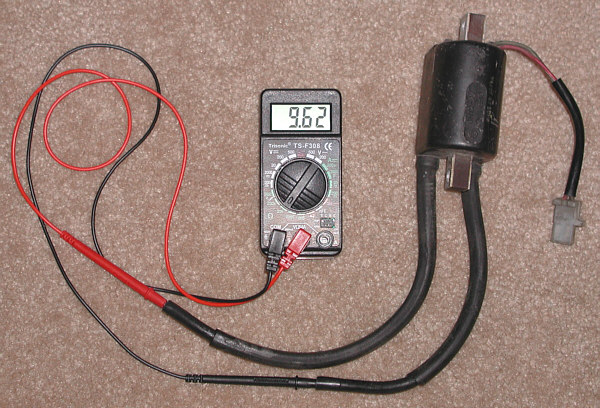
4. Measure secondary coil resistance
Secondary Coil Resistance:
12kΩ ±20% at 20°C (68°F)

5. Connect:
Electro tester 1
Fully charged battery 2 (to ignition oil leads)
3 No. 1 (Rear) cylinder high tension cord
4 Ground
5 R/W lead
6 O lead
6. Measure the ignition coil minimum spark gap Turn the spark gap adjuster and increase the gap to the maximum limit unless misfire occurs first.
Minimum Spark Gap: 6 mm (0.24 in)
PICKUP COIL
1. Remove:
• Left side cover
• Panel
2. Disconnect pickup coil wires from TCI unit wires.

3. Measure the pickup coil resistance. Use pocket tester.
Pickup Coil Resistance:
No. 1 and No. 4 cylinder (O — B)
No, 2 and No. 3 cylinder (Gy - B)
120Ω ± 10% at 20°C (68°F)
SIDESTAND RELAY
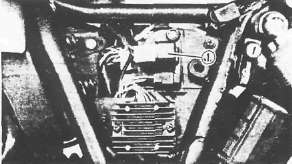
1. Remove:
• Left side cover
•Sidestand relay 1
2. Check the relay contacts

Use 12V battery 3 and Pocket Tester (90890-03112).
Battery Connected: ∞ 2
Battery Disconnected: 0Ω 1
SPARK PLUG
1. Check condition and replace if burned or fouled. Clean and regap as necessary.
CAUTION:
Be sure to use plugs of proper type
DR8ES-L (NGK) X24ESR-U (NIPPONDENSO)

Electrode Gap 1 :
0.6 ~ 0.7 mm (0.024 - 0.028 in)
2. Install spark plug
Spark Plug: 17.5 Nm (1.75m*kg, 12.5ft-lb)
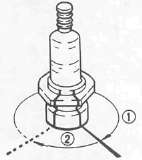
1 Finger tighten
2 Plug wrench tighten
Lighting System
Lighting SystemLIGHTING SYSTEM
3 Main switch
25 Flasher light (Front, Right)
26 Flasher light (Rear, Right)
27 "TURN" indicator light (Right)
28 "TURN" indicator light (Left)
29 Flasher light (Rear, Left)
30 Flasher light (Front, Left)
37 Tail/Brake light
39 Fuse "HEAD" (15A)
40 Meter light
41 Head light
42 "HIGH BEAM" indicator light
43 "LIGHTS" (Dimmer) switch
44 "START" switch
48 Battery
49 Fuse "MAIN" (30A)
TESTS AND CHECKS Headlight Troubleshooting
|
HEADLIGHT DOES NOT COME ON WHEN ENGINE IS RUNNING/HIGH BEAM DOES NOT OPERATION. |
|
|
|
▼ |
|
|
|
Check headlight. |
Faulty ►
|
Replace.
|
|
▼ |
||
|
Check head fuse. |
Faulty ►
|
Replace.
|
|
▼ |
||
|
Measure voltage on brown wire from main switch ("ON" position). |
Faulty
|
Check dimmer switch, replace if necessary.
|
|
▼ |
||
|
Measure voltage on blue/black wire from starter switch ("ON" position). |
No voltage
|
Check main switch, replace if necessary.
|
|
▼ |
||
|
No voltage
|
Check starter switch, if necessary.
|
|
|
Measure voltage at dimmer switch terminal. |
||
|
▼ |
||
|
An open or poor connection between headlight and dimmer switch terminal. |
||
|
Measure voltage at headlight high beam or low beam terminal. |
No voltage |
|
|
▼ |
|
|
|
|
||
|
Poor ground or poor connection of headlight wiring. |
||
Taillight Troubleshooting
|
TAILLIGHT DOES NOT COME ON WHEN ENGINE IS RUNNING. |
|
|
|
▼ |
|
|
|
Check taillight bulb. |
Faulty |
Replace. |
|
▼ OK |
|
|
Measure voltage on blue wire from main switch ("ON" position). |
No voltage |
Check main switch, replace if necessary. |
|
▼ 12v |
|
|
|
Measure voltage at taillight terminal. |
No voltage. |
An open or poor connection between taillight and main switch terminal. |
|
▼ 12v |
||
|
Poor ground or poor connection or taillight wiring. |
|
|
Signal System
Signal SystemSIGNAL SYSTEM
3 Main switch
15 Tachometer
16 "FUEL" warning light
17 Fuel sender
20 Horn
21 "HORN" switch
22 Flasher relay (Relay assembly)
23 Flasher switch
24 Reed switch
25 Flasher light (Front, Right)
26 Flasher light (Rear, Right)
27 "TURN" indicator light (Right)
28 "TURN" indicator light (Left)
29 Flasher light (Rear, Left)
30 Flasher light (Front, Left)
31 "OIL LEVEL" indicator light
32 Oil level switch
33 "NEUTRAL" indicator light
34 Neutral switch
35 Fuse "SIGNAL" (15A)
36 Brake switch
37 Tail/Brake light
44 "START" switch
48 Battery
49 Fuse "MAIN" (30A)
50 Diode assembly
FLASHER LIGHT Troubleshooting
|
Flasher light and indicator light inoperative. |
||
| ▼ | ||
|
Check bulb. |
Faulty ► |
Replace.
|
|
▼OK |
||
|
Measure voltage at flasher switch (Br/W wire and Y/R wire). |
12V |
Check flasher switch, replace if necessary.
|
|
▼ No voltage |
||
|
Check flasher relay, main fuse, signal fuse and battery. |
Faulty and/or battery discharged . ► |
Replace faulty parts and/or charge battery.
|
|
▼ OK |
||
|
Check reed switch. |
Defect ► |
Replace.
|
|
▼ OK |
||
|
Replace flasher relay (Relay assembly). |
||
FLASHER RELAY (Relay Assembly)
NOTE
Flasher relay and self cancelling unit are included with relay assembly.
The flasher relay turns off the flashers. Generally the signal will cancel after either 10 seconds of operation or after the motorcycle has traveled 150 meters (490 feet), whichever is greater. At low speed, the cancelling is a function of distance; at high speeds, it's a function of both time and distance.
The flasher switch has three positions: L (left), OFF, and R (right). The switch lever will return to the "OFF" position after being pushed to L or R, but the signal will function. By pushing the lever in, the signal may be cancelled manually.
REED SWITCH
1. Remove:
• Headlight unit
• Headlight body
2. Disconnect the coupler
3. Connect pocket tester
4. Lift the front wheel and rotate the wheel by hand.
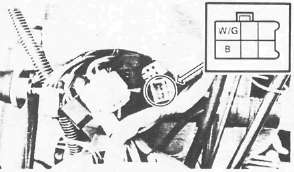
5. Measure reed switch resistance
Reed Switch Resistance: About 7 Then return back OΩ or ∞Ω when wheel is stopped
OIL LEVEL INDICATOR LIGHT
1. Troubleshooting
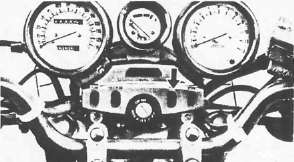
|
Oil level indicator light inoperative |
|||
|
Check bulb |
Faulty |
Replace |
|
|
▼ OK |
|
|
|
|
Measure voltage at oil level switch (Red/Black) |
No voltage |
Check diode, signal fuse, main switch, main fuse, and battery. Replace faulty parts. |
|
|
▼ 12V |
|
|
|
|
Check oil level switch, replace if necessary. |
|
||
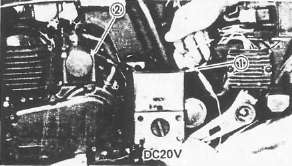
1 Red/Black lead
2 Ground
FUEL WARNING INDICATOR LIGHT
1. Troubleshooting

|
Fuel warning indicator light inoperative |
|||
|
▼ |
|
||
|
Check bulb |
Faulty |
Replace |
|
|
▼ OK |
|
|
|
|
Measure voltage at fuel sender unit (Green). |
No voltage |
Check signal fuse, main switch, main fuse, and battery. Replace faulty parts. |
|
|
▼ 12V |
|
||
|
|
|||
|
Check fuel sender, replace if necessary. |
|
||

1 Green
2 Black
FUEL SENDER UNIT
1. Remove seat
2. Fill the fuel tank (with gasoline)

3. Measure the fuel sender unit resistance.
Fuel Sender Unit Resistance: 1.1 ±0.2kΩ @ 20°C (68°F)
NEUTRAL INDICATOR LIGHT
1. Troubleshooting
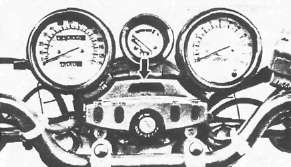
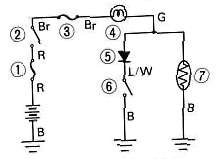
1 Main fuse
2 Main switch
3 Signal fuse
4 Fuel warning indicator Igiht
5 Diode
6 Starter switch
7 Fuel sender
|
Neutral indicator light inoperative |
||
|
|
||
|
Check bulb |
Faulty |
Replace
|
|
▼ OK |
||
|
Measure voltage at neutral switch (Sb wire) |
No voltage |
Check signal fuse, main switch, main fuse, and battery, Replace faulty parts. |
|
▼ 12V |
|
|
|
|
||
|
Check neutral switch. Replace if necessary. |
|
|

1 Blue lead
2 Ground
HORN
1. Check:
|
Check for: |
Horn inoperative |
|
12V on brown lead to horn |
|
|
Good ground (horn/pink wire) when horn button is pressed |
|
|
Faulty |
Defective components — Replace.
NOTE:
There are individual fuses for various circuits (See Complete Circuit Diagram)

2. Measure the horn resistance
Horn Resistance: 1.05Ω ± 10%
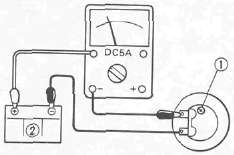
3. Adjust the volume. Turn the adjuster 1 in and out so that the volume is maximum at the maximum amperage.
2 Battery (12V)
|
Tester's lead wire |
Maximum Amperage |
Tester's range |
|
|
Red lead |
Black lead |
||
|
Battery (+) lead |
Horn lead and Battery (-) lead |
2.0A |
DC5A |
BRAKE LIGHT
|
Check for: |
Brake light inoperative |
|
Defective bulb |
|
|
12V on yellow lead to brake light |
|
|
12V on brown lead to each brake light switch (Front and rear brake switch) |
Switches
SwitchesSWITCHES
Use Pocket Tester (90890-03112) on "Ohm x 1" scale to check the switches. Replace any "shorted" or opened element.
Main Switch
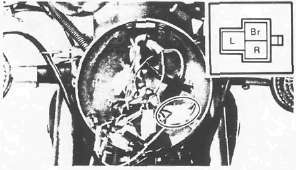
|
Switch position |
Lead color |
||
|
R |
Br |
L |
|
|
ON |
|
|
|
|
OFF |
|
|
|
|
P |
|
|
|
"ENGINE STOP" Switch
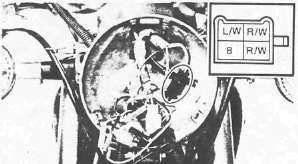
|
Switch position |
Lead color |
|
|
R/W |
R/W |
|
|
RUN |
|
|
|
OFF |
|
|
"START" Switch
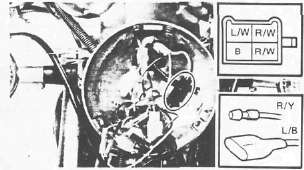
|
Switch position |
Lead color |
|||
|
L/W |
B |
R/Y |
L/B |
|
|
OFF |
|
|
|
|
|
ON |
|
|
|
|
"LIGHTS" (Dimmer) Switch
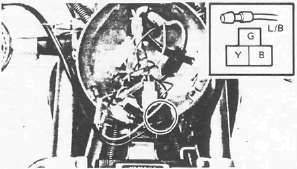
|
Switch position |
Lead color |
||
|
Y |
L/B |
G |
|
|
HI |
|
|
|
|
LO |
|
|
|
"HORN" Switch
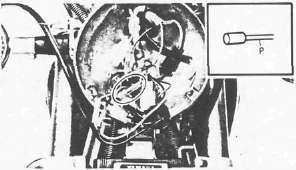
|
Switch position |
Lead color |
|
|
P |
Ground or B |
|
|
PUSH |
|
|
|
OFF |
|
|
'TURN" Switch

|
Switch position |
Lead color |
|||||
|
Dg |
Br/W |
Ch |
Y/R |
B |
||
|
R |
|
|
|
|
|
|
|
N |
R |
|
|
|
|
|
|
N |
|
|
|
|
|
|
|
L |
|
|
|
|
|
|
|
L |
|
|
|
|
|
|
Oil Level Switch
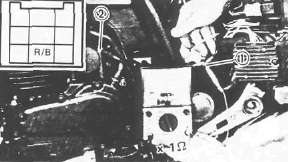
|
Switch position |
Lead color |
|
|
R/B |
Ground |
|
|
ON |
|
|
|
OFF |
|
|
Front Brake Switch
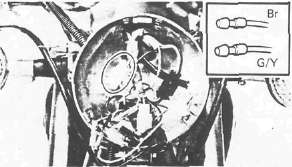
|
Switch position |
Lead color |
|
|
Br |
G/Y |
|
|
ON |
|
|
|
OFF |
|
|
Rear Brake Switch

1 Switch body
2 Adjusting nut
|
Switch position |
Lead color |
|
|
Y |
Y |
|
|
ON |
|
|
|
OFF |
|
|
Cooling System
Cooling SystemCOOLING SYSTEM
3 Main switch
4 Fuse "FAN" (10A)
5 Thermo switch
6 Fan motor
18 Temperature meter
19 Thermo unit
35 Fuse "SIGNAL" (15A)
48 Battery
49 Fuse "MAIN" (30A)
TROUBLESHOOTING CHART (1)
|
TEMPERATURE GAUGE DOES NOT OPERATE. |
||
|
▼ |
||
|
Remove the fuel tank. |
||
|
▼ |
||
|
Turn the main switch "ON". |
||
|
▼ |
||
|
Disconnect the thermo unit connector. Check the battery voltage (12V) on Green/Red lead from the wire harness, |
No |
Check for an open or poor connection between the fuse "SIGNAL" and thermo unit connector. |
|
▼ Yes |
||
|
Disconnect the thermo unit connector. Connect the Green/Red lead from the wire harness to "ground" on the frame; use a jumper lead 1 . |
No ► |
Replace the temperature gauge. |
|
▼ |
|
|
|
The temperature gauge needle will swing from "C" to "H". |
||
|
▼ Yes |
||
|
Replace the thermo unit. |
TROUBLESHOOTING CHART (2)
|
ELECTRIC FAN MOTOR DOES NOT OPERATE. |
||
|
▼ |
||
|
Disconnect the thermo switch 1 lead.
|
||
|
▼ |
||
| Check for the battery voltage (12V) on Brown lead from the wire harness. | No ► |
Check for an open or poor connection between the fuse "FAN" and thermo switch connector. |
| ▼ Yes | ||
|
Connect the Brown lead and Blue lead; use a jump lead 1 .
|
||
| ▼ | ||
| The fan motor operates. | No ► |
Replace the fan motor. |
| ▼ Yes | ||
| Replace the thermo switch. | ||
THERMO UNIT AND THERMOMETER
Operation
The thermo unit has less resistance at higher temperatures and thus allows more current to pass through. When more current flows to the coil in the temperature gauge; the armature to which the needle is attracted by the increased magnetic field. In this way, the needle indicates the temperature.
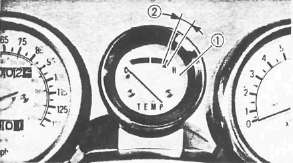
1 Temperature gauge
2 Red zone
Thermo Unit Inspection

1. Remove:
• Thermo unit 1
CAUTION:
Handle the thermo unit with special care. Never subject it to strong shock or allow it to be dropped. Should it be dropped, it must be replaced.
2. Check the thermo unit operation
Thermo unit inspection steps:
• Immerse thermo-unit in water.
• Check continuity at indicated temperatures. Note temperatures while heating the water.

1 Temperature gauge
2 Thermo unit
3 Pocket tester
4 Water
|
Water Temperature |
50°C (122°F) |
100°C (212°F) |
120°C (248°F) |
|
Resistance |
156Ω |
28.4Ω |
17Ω |

3. Install the thermo unit 2
4. Tighten the thermo unit
Thermo Unit 2 : 15 Nm (1.5m-kg, 11 ft lb)
CAUTION:
After replacing the thermo unit, check the coolant level in the radiator and also check for any leakage.
ELECTRIC FAN AND THERMO SWITCH
Operation
The electric fan will be switched ON or OFF according to the coolant temperature in the radiator.
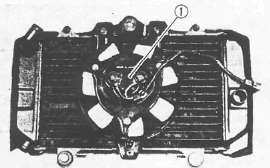
1 Electric fan motor
NOTE:
The electric fan is controlled by the thermo switch when the main switch is "ON". Thus, under certain operating conditions, this fan may continue to run until the engine temperature has cooled down to about 98°C (208.4°F).

A THERMO SWITCH "ON"
B COOLANT TEMPERATURE
|
The following problems may require repair or replacement of components |
|
|
Component |
Condition |
|
Fan motor |
Unsmooth operation |
|
Fan motor bracket |
Cracks |
|
Securing bolts |
Looseness |
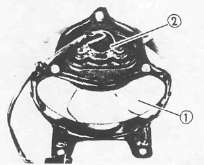
1 Fan
2 Electric fan motor
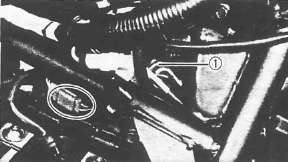
Thermo Switch Inspection
1. Remove the thermo switch 1
CAUTION:
Handle the thermo switch very carefully. Never subject it to strong shock or allow it to be dropped. Should it be dropped, it must be replaced.
2. Inspect the thermo switch operation
Thermo switch inspection steps:
• Immerse thermo switch in oil.
• Check continuity as indicated temperatures. Note temperatures while heating the oil.

1 Temperature gauge
2 Thermo switch
3 Pocket Tester
4 Oil
|
Test step |
Oil temperature |
Pocket Tester (Ω x 1) |
|
1 |
0- 98°C (32~208.4°F) |
Discontinuity |
|
2 |
More than 105°±3°C (more than 221.0 ±5.4°F) |
Continuity |
|
3* |
105 to 98°C (221.0- 208.4°F) |
Continuity |
|
4* |
less than 98°C (less than 208.4°F) |
Discontinuity |
Test 1 & 2: Heat-up tests
Test 3* & 4*: Cool-down tests
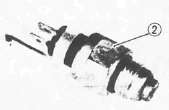
3. Install the thermo switch 2
Thermo Switch 2 : 23 Nm (2.3 m-kg, 27 ft-lb)
CAUTION:
After replacing ther thermo switch, check the coolant level in the radiator and also check for any leakage.


